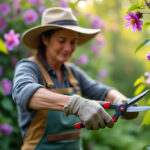Sunflowers are an essential component of mid- to late-summer gardens, celebrated for their striking colors and cheerful disposition. These annual flowers are not only visually captivating, but they’re also quite easy to cultivate and maintain. With the fascinating ability to follow the sun’s path throughout the day, sunflowers bring a unique charm to any outdoor space. If you’re looking to add these vibrant beauties to your garden in 2025, understanding the best times and practices for planting can make all the difference.
- When to Plant Sunflowers
- How to Grow Sunflowers
- How to Care for Sunflowers
- Harvesting Sunflowers for Bouquets and Seeds
- Common Questions about Sunflowers
When to Plant Sunflowers
For successful sunflower cultivation, timing is crucial. It’s advisable to sow sunflower seeds directly in the garden after the danger of spring frost has passed. This typically occurs once soil temperatures reach the comfortable mid-60s to 70s Fahrenheit (around 18-24°C). In many regions, this means planting between late April and mid-June. Notably, sunflowers don’t respond well to transplantation, so direct seeding is recommended.
The days required for sunflowers to bloom vary by species, ranging from approximately 50 to 120 days. Noting the number of days to maturity on your seed packet will help you assess the latest possible sowing date to enjoy blooms before the first frost. Connecting with your local extension service can provide you with precise frost dates, ensuring your sunflowers thrive this season.
How to Grow Sunflowers
Sunflowers thrive in full sunlight, necessitating at least six to eight hours of direct sun per day. Choose a well-drained area in your garden, avoiding shaded spots. To plant, create holes approximately an inch deep and space seeds about 6 to 36 inches apart, depending on the variety. For those growing smaller sunflowers in containers, they can be planted closer together. Water thoroughly and keep the soil consistently moist until the seedlings emerge, usually within a week to ten days.
If you prefer a staggered blooming period, consider planting seeds at intervals of a few weeks. If pesky birds or rodents threaten your seeds, protect the area with chicken wire or cloches for peace of mind. Regularly checking in on your young plants and thinning them to maintain the healthiest specimens will lead to a stunning sunflower display.
How to Care for Sunflowers
One of the appealing aspects of sunflowers is their resilience; they don’t require excessive care. Once established, these flowers require occasional watering during dry spells. Fertilization is rarely necessary, but can be beneficial if desired. Large sunflowers, however, may need staking to prevent them from toppling due to heavy flower heads or high winds. Simple supports like bamboo stakes or any sturdy material you have at hand can provide the needed reinforcement.
| Watering Frequency | Fertilization Needed | Presence of Pests |
|---|---|---|
| Once a week | Usually unnecessary | Generally minimal |
Moreover, these flowers are remarkably heat-tolerant and attract a myriad of pollinators, enhancing the biodiversity of your garden. Remember that the sunflower’s botanical name, Helianthus annuus, emphasizes its sun-seeking nature, a trait emblematic of its lively character.
When is the best time to prune honeysuckle for optimal growth?
Harvesting Sunflowers for Bouquets and Seeds
To cut sunflowers for indoor arrangements, harvest them just before the flower bud opens to encourage side blooms. Early morning is ideal for cutting; this timing helps prevent wilting. After cutting, strip the leaves from the lower stems and recut them at a 45-degree angle. To ensure longevity, change the water daily and support the heavy heads in a sturdy container.
If you’re keen on capturing sunflower seeds for snacks or planting, allow the flowers to dry on or off the stem until their heads turn brown and the seeds feel loose. Use scissors to cut the heads several inches below the flower, then gently rub to release the seeds. This autumn ritual not only provides tasty treats but also contributes to next year’s planting.
Common Questions About Sunflowers
- What is the best fertilizer for sunflowers? While they can grow without it, organic compost or a light application of a slow-release fertilizer can boost growth.
- Do sunflowers require a lot of water? Once established, sunflowers are fairly hardy; they thrive with minimal watering.
- Can you grow sunflowers in containers? Yes, smaller varieties are ideal for pots, making them perfect for balconies or small spaces.
- Are there any pests I should watch out for? While sunflowers are generally pest-resistant, keeping an eye out for sunflower moths and using natural deterrents can help.
- What varieties are recommended? For diverse choices, consider brands like Burpee, Park Seed, and High Mowing Organic Seeds, which offer a wide range of options.
With all the vibrant attributes of sunflowers, from their sunny disposition to their charming presence in bouquets, they remain a gardener’s favorite. As 2025 unfolds, make the commitment to enrich your garden with these lovely flowers and enjoy the beauty they bring to your outdoor spaces. 🌻✨
















